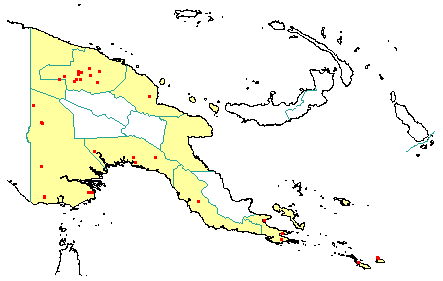
in PNGplants database
PNGTreesKey – Vatica rassak (Korth.) Blume |
Barry Conn (NSW) & Kipiro Damas (LAE).
Guide to trees of Papua New Guinea
Copyright held by the authors, National Herbarium of New South Wales, and Papua New Guinea National Herbarium
Museum Botanicum Lugduno-Batavum sive stirpium Exoticarum, Novarum vel Minus Cognitarum ex Vivis aut Siccis Brevis Expositio et Descriptio Vol. 2: 31 (1852)
Other Literature: P.S. Ashton, Tree Flora of Sabah and Sarawak 381-382 (2004)
Family: Dipterocarpaceae
Dicotyledon
Timber Group: Occasional timber species
Field Characters: Large canopy tree (15-30 m high) or Small sub-canopy tree; Bole cylindrical (20-80 cm diam.); straight (bole 5-20 m long); buttresses buttresses absent; spines spines absent; aerial roots aerial roots absent; stilt roots stilt roots absent; Bark white, grey, or brown (greyish to greenish brown), smooth; Subrhytidome (under-bark) brown; less than 25 mm thick, 6.0-8.0; bark blaze consisting of one layer; faintly to non-aromatic; outer blaze yellow or brown, markings absent, slightly fibrous; inner blaze yellow or brown, markings absent, slightly fibrous; bark exudate (sap) present, white/milky or pale yellow, not readily flowing (spotty), colour changing on exposure to air, to golden-coloured, sticky; terminal buds not enclosed by leaves.
Indumentum: Complex hairs absent; stinging hairs absent; mature twig indumentum (hairs) absent.
Leaves: Leaves spaced along branches, spiral (leaves occurring singly at a node and arranged spirally up the branchlet), simple (a leaf composed of a single blade); petiole present, not winged, attached to base of leaf blade, not swollen; leaves broadest at or near middle or equally broad throughout much of length, (11.0-) 15.0-30.0 cm, 7.0-10.0 cm; symmetric, entire, not dissected or lobed, occasionally obtuse or acuminate (shortly), venation palmate, secondary veins open, prominent, intramarginal veins absent; leaves lower surface pale green or greenish grey, upper surface dark green (glossy), indumentum (hairs) present; absent; domatia absent; stipules present, free, laterally placed, not encircling the twig, leafy, not fringed, large, not persistent.
Flowers: Inflorescence axillary, flowers on a branched axis, cones absent; flowers bisexual, stalked, flowers with many planes of symmetry, 8.0-12.0 mm long, diameter small (up to10 mm diam.) (4-6 mm diameter); perianth present, with distinct sepals and petals whorls, inner perianth white or cream-coloured; 5, free; stamens 5, present, free of each other, free of the perianth; ovary superior, carpels joined (when more than one), locules 1; styles solitary, 1.
Fruits: Infrutescence arranged on branched axis, fruit 40.0-50.0 mm long, 25.0-30.0 mm diam., brown (with persistent green calyx), not spiny, non-fleshy, simple, dehiscent, capsule (fruit often regarded as a nut that splits longitudinally into 3 equal valves at germination); seeds 1, much more than 10 mm long (c. 25 mm long), winged (by misinterpretation (actually 1-seeded fruit winged) or not winged, narrow (longer than wide), seed more than 10 mm diam.
Distribution: West Sepik, East Sepik, Madang, Morobe, Western, Gulf, Central, Milne Bay & Papuan Islands.
 | Botanical records in PNGplants database |
Notes: Notes Formerly known as Vatica papuana Dyer.